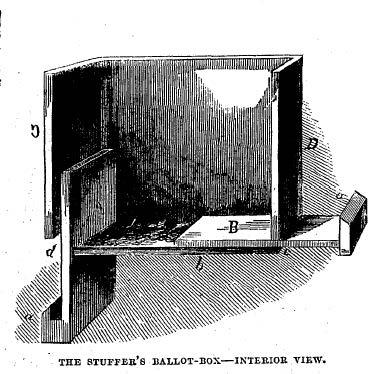Democracy is the hole in the stuffed shirt through which the sawdust slowly trickles….
E.B. White, The New Yorker, 1943
Among the calamities of War may be justly numbered the diminution of the love of truth, by the falsehoods which interest dictates and credulity encourages.
Samuel Johnson, The Idler, 1758
He wisely makes no distinction as to whether the war in question is just or not. And wars waged on the behalf, partial behalf, or alleged behalf of democracy are no exception to the rule. The truth is just too tricky to be done in by the blunt instrument of war. Once upon a time, Colin Powell knew he could not prove what he was saying but he said it anyway, as if he could , and yet there were no Weapons of Mass Destruction in Iraq. Once upon a time, Lyndon Johnson said that the war in Vietnam could be won without the United States occupying that country for an indefinite length of time, and so he tried, and as he did so,purged all resistors.
As soon as the Second World War began, much of the truth about America’s participation in it was given a makeover, fogged up, shrouded. It was a just war, without question, and it was waged against forces that made pacificists into moral dilettantes. But the heroes were two-faced when needed.
The war against fascism did not begin when the passenger ship St. Louis, full of Jewish refugees, fleeing for their lives, sought safety in American harbors in 1939. The United States, at the time, did not want to take even that controversial step, much less get the old draft board back together. So St. Louis sailed back to Europe, and you can guess the rest. Likewise, the estimated 50,000 to 300,00 civilian noncombatants slaughtered by the army of Imperial Japan after the seizure of Nanjing, China, was sufficient cause for an alarm to arms.
It would take more than that. “America First” was hardly just one of Charles Lindbergh’s simple minded slogans, employed to disguise, poorly, his own anti-Semitism. It was the country’s common sentiment and, in spite of subsequent claims of heeding the call to saintliness and martyrdom, this was the primary sentiment validated on the days of VE and VJ. Were it not for a delusion gamble at Pearl Harbor–a calculation based partly upon the a misreading of the popularity of the stateside, stay-out-of-a-war-at-all-costs message–America may have gone on turning a blind eye to crimes against humanity for far longer than it did, and, in doing so, may have even, ultimately, denied itself one of its most favored patriotic tropes: we went to war to fight the fascists and won. Actually, we went to war mainly because some of our own actual guys were dead, and we were pissed off because the other guy got in a sucker punch when we weren’t looking. You can’t take that sort of thing sitting down.

WWII Japanese Propaganda 
WWII American Propaganda
No matter how clear-eyed and factual the journalism produced in the Second World War by Ernest “Ernie” Pyle (August 30, 1900 – April 19, 1945) may have been, it was a cog in the American wartime propaganda machine. He himself may have been the finest cog of all. In his widely successful, syndicated newspaper column–published in 400 daily and 300 weekly newspapers–he took what he called “the worm’s eye view.” He was unapologetic in his frequently troubling, even depressing, depiction of life as lived by Americans on the front lines, where mud, blood, death, rain, terror, loneliness and boredom were ever present. His subjects were exhausted and “dog faced” and mangled. He asked to be embedded in infantry battalions because they were on the front lines and “because they are the underdog.”He was hospitalized on two occasions for “war neurosis,” and he died while reporting on the island of Iejima on April 18, 1945, when the end of the war was already well in sight.
And the censors–and there were censors a plenty, looking at letters, listening to conversations, black balling edgy commentary–went on and let him do this sort of reporting: partly and precisely because Pyle always concentrated on the personal and the anecdotal. He only took close ups. Nothing wide angled. He didn’t mull over the harder, bigger questions. Was it right for the United States to intern its own citizens due to their ancestral nation of origin, a nation that for many lay generations in the past? Pyle expressed no opinion. Wasn’t bombing and incinerating civilian noncombatants getting pretty damned close to the territory of fascism, which we were supposedly distinguishing ourselves from and fighting against and liberating others from? Pyle didn’t say. Thus he was allowed to talk..
Allowed? He was encouraged to go on talking, and to go on talking in that Ernie Pyle sort of way of his, while putting his own life and mental health at risk in order to get the story. Pyle’s propaganda was propaganda that worked. Take a look at that enviable subscription of his. Edward R. Morrow, reciting his practically Shakespearean accounts from London during the blitz, was the better writer. But Pyle reached farther and deeper than Morrow into the American head and America loved him. With scarcely a single adjustment to his own reported facts, while omitting ugly ones like Japanese interment camps and government sponsored, anti-Asian racist bile, he was a self-made, homegrown, aw-shucks, common man martyr. Jimmy Stewart with a case of the shakes. Shortly after his death, Burgess Meredith portrayed him in The Story of G.I. Joe, a rah-rah, red, white, and blue bit of Hollywoodiana.
President Harry Truman, the commander-in-chief responsible for the crimes of Hiroshima and Nagasaki, said of Pyle, “No man in this war has so well told the story of the American fighting man as American fighting men wanted it told. He deserves the gratitude of all his countrymen.”

Their life consisted wholly and solely of war, for they were and always had been front-line infantrymen. They survived because the fates were kind to them, certainly – but also because they had become hard and immensely wise in animal-like ways of self-preservation.
Ernie Pyle, “The Death of Captain Waskow,” January, 1944
Propaganda, without question. But of a very specific kind. With a very specific audience always in mind. “Animal-like ways of self-preservation” doesn’t seem to have much to do with the supposed, beneficent ideals of democracy. Or with any ideal at all, really, it would seem. And yet it is also true that it wasn’t entirely bullshit, either. Far from it. It was propaganda based upon verifiable, discomforting, consensual reality. It was propaganda of a very American–and one might even extrapolate, democratic–kind, then, based upon the premise that the communication of uncompromised reality, might, as E.B. White hoped, confront fascist lies and punch a “hole in the stuffed shirt through which the sawdust slowly trickles.”
His propagandistic style was in unmistakable opposition to the style employed by Germany and Japan which was to make the war sublime. Even on the rare occasions that the reality of the battlefield happened to worm its way into fascist theater productions–in spite of great odds…, undeterred by their losses…, meeting a hero’s death… –this sacrifice of one’s self and of those one loved, in the service to unearthly cause, was always to the categorical good. There was no doubt, no hesitation, and no emotion, ultimately, than one of joyful destruction and of joyful self-immolation. While there were plenty of glossy, glassy eyed American, Christian soldiers, who were also portrayed marching and flying off to heaven, there was, at least, sufficient discursive room, the story of sufficiently accessible and questionable, as to allow a vision such as Pyle’s to exist in the first place.
This vision, however it may have been used, was based upon the presumption that telling the truth was a virtue in and of itself. It was a virtue which, perhaps, surpassed all others in importance–you would die not for its sublimity, but for its very facticity–and that would punch an unstaunched and fatal hole, as E.B. White, the American master of plain speech hope, in the stuffed shirt of grandiose lies, upon which fascist ideologies, and fascists motivations, so relied.
None of which is to say that the Axis powers lost the Second World War because their propaganda was in any way inferior. For its purpose, speaking to its audience, it was no doubt successful to some degree, as demonstrated by the Japanese kamikaze pilots who flew upon a divine wind even though the war was lost. The carnage, instead, had to continue. It was as the emperor said: should American G.I.’s reach the home islands, they were going to slaughter everyone in sight. So, buck up, soldier. Stay strong. For the sake of your dear, old mother, if not for yourself.


Well, so much for that kind of patriotic shit.
Who could have imagined that, in the end, the only meaningful difference between Elise Stefanick (R-NY), the newly elected chair of the House Republican Conference, and Liz Cheney (R-WY), whom she replaced, would be one of epistemology?
What, Willis, are you talking about?
But that is precisely and only what the contretemps was all about when Liz Cheney (R-WY) squared off with Elise Stefanik (R-NY) to do battle over the position of Chair of the House Republican Conference. Policy wise, Stefanik has, until now, been markedly to the left of Cheney. But policy wasn’t the issue. The issue was “the big lie,” a term that was once almost exclusively associated with Joseph Goebbels’ Ministry of Propaganda, that Donald Trump is, at the present moment, the rightful and legitimate President of the United States. Cheney wasn’t willing to tell it. Stefanik was. And therein was the whole of the matter. Look who won.
Although a few hardliners got a little red-faced flustered by the fact, it didn’t matter that, when she was first ran for office in 2015, Stefanik told local journalists, “I will work with anyone, regardless of their party affiliation, to get it done. Republicans, Democrats, independents, even Green Party — if you have a good idea, I’m willing to work with you to get the job done.” It didn’t matter that she voted against Trump’s absurd tax cuts, that she supported the Mueller investigation and expected “complete transparency” from the White House, or that she believed Trump’s immigration policies were inimical to American values, and they did not represent “where we are as a country.”
All that matters now is that she believes–or said she that believes or that she is willing to say out loud –that Brad Raffensberger, the Georgia Secretary of State, had counted approximately 140,000 votes from “underage, deceased, and otherwise unauthorized voters” that all broke on behalf of Joe Biden.
Stefanik’s whopper makes Trump’s own claim that Raffensberger only needed to “find” 11,780 as yet undiscovered votes to keep Georgia red seem modest, in comparison.

Driving through New York’s 21st Congressional District in 2016, judging by the number and the kinds of signs in yards, it was easy to understand Stefanik’s pragmatic, middle-of-the-road approach during her debut campaign. The district had favored Barack Obama by wide margins, twice. The retiring representative, Paul Tonko, a standard issue Democrat, was popular and would have won again, if he had chosen to run. To the eye, the upstate district resembled,-and it continues to resemble, to the same eye,the rest of rural New England. Some empty factories and some empty main streets. Some working factories and some busy main streets. A field of solar panels. Pro-business, family farms. Pockets of arty, lefty types, who fled the downstate rents that just got too damn high. The guy at the end of the road who lives in a trailer and who flies the Confederate battle flag and has a dog on chain and doesn’t want to talk about any of it.
They all lived, fairly peaceably, side by side.
In other words, it was the kind of place where a white, female, fiscally conservative, socially liberal, non-ideological Republican like Stefanik–an inheritor of the old, and dying, New England Republican tradition–might be able to buck the region’s steady leftward trend. Her 2016 opponent was a heavily endorsed, political neophyte who ran an amatuer hour campaign. Casting herself as a no nonsense, Main Street friendly wonk in the mold of Paul Ryan–whom she had worked for and whom she regarded as a close personal friend, as she was quick to point out, she indeed bucked, winning her district by 14 points, and the residents of Ogdensburg, Glens Falls, Plattsburgh, and Watertown got the pragmatist they said they wanted.
How the worm turns. How the sawdust trickles. These days, that’s a puny margin for a typically lopsided Stefanik win.
Thus the tiresome, almost useless question is asked, yet again. Does Stefanik, with her Harvard education, really believe that Donald Trump is the legitimate President of the United States? The shortest and most truthful answer? Or course she doesn’t. To believe such a thing would require her to disavow every principle and practice of the whole of Western jurisprudence. Admissibility of evidence, due process, stare decisis, all of it. She doesn’t believe that any more than Mitch McConnell thinks that a bipartisan panel looking into the January 6 putsch will lead to nothing more than a partisan hit job. Or any more than Sidney Powell thought that Hugo Chavez–or was it his ghost?—-managed to install a socialistical puppet in the White House.
In the course of human affairs, the normal and the perverse are always locked in a tight dance. What’s more, they are likely to change up who leads and whom follows. Or, to use another tired phrase, when they go walking, you never know for sure which one will do the talking. And, at the moment, it is a given that that one will pervert the truth, for this is a badge of acceptance, a pledge of fealty, the new social contract within the GOP. And this is a logical progression when you know–like Stefanik–that truth can divide as easily as it can unite. She might not believe it, but her constituents do,so take that Reality Principle! Embracing a lie in order to belong to a zealous, identity-affirming, cohesive group is simply more important than parsing the alleged intricacies of propaganda and disinformation. Just because facticity beat sublimity once doesn’t mean that it always must be so, every time they meet and fight it out. Neither is, essentially or intrinsically, a more reliable source of good propaganda. Propaganda isn’t the truth, after all. It is what works.
Although riddled with omissions, Pyle wrote and became popular with the presumption that the truth, well told, however personal, degrading, and personally horrific, was a communicative act that could unify. Curiously, once upon a time, truth did work this way, in the stylistics of American propaganda. At the moment, though, trying to tell the uncomfortable truth among propagandists like Stefanik, Ernie Pyle-style, is yesterday’s dog food. A brave, new American way world is being born inNew York’s 21st congressional district, and in Alabama’s 2nd, and in Georgia’s 14th, and to points beyond. Ernie Pyle was a mainstream media stooge, a lapdog of the coastal elite, and a Democrat, after all. He thought the New Deal was great. He didn’t put America First. He thought that America should have gone to war long before Pearl Harbor sealed the deal. America First, finally and forever and only, probably wouldn’t sound much like a place where he would want to live.


